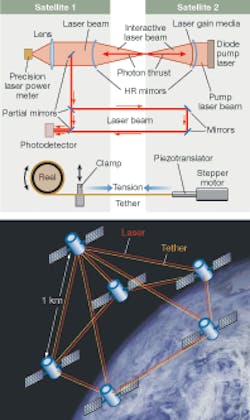LASERS IN SPACE: Photon thrusters may enable satellite formations with nanometer accuracy
Rather than building a monolithic satellite with a large aperture or large sample-collection area (with its associated weight and station-keeping costs), formation flying of clusters of micro-, nano-, or picosatellites is recognized as a lightweight alternative. Although many formation-flying systems have been proposed, including microwave scattering, a Coulomb-force concept, and a magnetic-dipole-interaction concept, each of these techniques has negative attributes and cannot yet maintain the required nanometer accuracy over a 200 m distance that is required, as an example, for the proposed MicroArcsecond Imaging Mission (MAXIM) satellite—an x-ray interferometer for space-imaging applications under development by NASA (Washington, D.C.).
But NASA may have a solution in ultra-high-precision laser intracavity thrusters that provide a continuously adjustable separation between sensor or optical elements within a satellite array connected by Kevlar or quartz tethers. This patent-pending photon tether formation flight (PTFF) system, proposed by Young K. Bae, president and chief scientist of the Bae Institute (Tustin, CA), is designed to enable intersatellite distance accuracy of nanometers at maximum estimated distances on the order of tens of kilometers.1
Bouncing photons
The PTFF system depends on a pulling-in force provided by tether tension and a pushing-apart continuous-wave (CW) thrust from the intracavity photon thruster (see figure). Because the thrust produced by single bounces of photons off a mirror is negligibly small, Bae uses an intracavity geometry that allows photons to bounce tens of thousands of times between two mirrors. The required millinewton forces for a 100 kg satellite arm can be obtained by a 10 W diode-pumped Nd:YAG laser; however, the laser power and tether diameter can be scaled depending on satellite weight. The mirrors are positioned in a self-aligning confocal resonator configuration consisting of two identical concave spherical mirrors separated by a distance equal to the radius of curvature of the two mirrors. The maximum attainable intracavity laser power is determined by the mirror reflectance and the power saturation and thermal-management capacity of the gain media.
The photon-thrusting force is balanced by the tether tension; the length of the tethers is adjusted by piezoelectric translators and stepper motors to an accuracy of better than 1 nm. A computer controls the pushing and pulling forces in real time, damping any vibrations or perturbations induced by the motions of the satellite arms.
To monitor the intersatellite distance, a highly sophisticated laser-interferometric ranging system is proposed for future satellites. The photon-thruster laser configuration would allow (by using a partially reflecting mirror located in the extracavity) the thruster laser to have a dual purpose as the interferometric ranging laser. This dual usage would simplify the satellite design and further reduce weight and power consumption.
Bae estimates that the lifetime of the PTFF system could be tens of years, assuming that the laser system could be operated below maximum power and the pump diodes could be replaced by a carousel mechanism.
The detailed mission-specific technical analyses and supporting engineering studies to realize the PTFF hardware for future space satellites is currently under way, thanks to a $75,000 grant provided to Bae by the NASA Institute for Advanced Concepts (NIAC; Atlanta, GA). “NIAC has been funding the most revolutionary aeronautics and space concepts, such as the Space Elevator, that could dramatically impact not only how NASA develops and conducts its missions, but worldwide space technology,” says Bae.
“The application of PTFF is extensive and includes astronomical, GPS, precise geophysical monitoring, environmental monitoring, mapping, imaging, or surveillance applications,” he notes. “Because the development of PTFF is a multidisciplinary effort, we are currently forming a team of scientists and engineers specialized in intracavity lasers, space tethers, interferometric ranging, membrane telescopes, and computer simulation. Especially, the development of the intracavity photon thruster is crucial, and needs a new laser design that maximizes the intracavity laser power.”
REFERENCE
1. Y.K. Bae, J. American Inst. of Physics Space Technology and Applications International Forum (STAIF) CP813, 1213 (2006).
About the Author

Gail Overton
Senior Editor (2004-2020)
Gail has more than 30 years of engineering, marketing, product management, and editorial experience in the photonics and optical communications industry. Before joining the staff at Laser Focus World in 2004, she held many product management and product marketing roles in the fiber-optics industry, most notably at Hughes (El Segundo, CA), GTE Labs (Waltham, MA), Corning (Corning, NY), Photon Kinetics (Beaverton, OR), and Newport Corporation (Irvine, CA). During her marketing career, Gail published articles in WDM Solutions and Sensors magazine and traveled internationally to conduct product and sales training. Gail received her BS degree in physics, with an emphasis in optics, from San Diego State University in San Diego, CA in May 1986.
